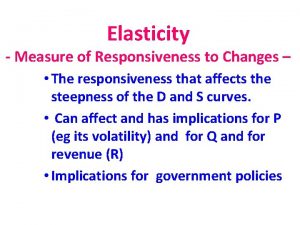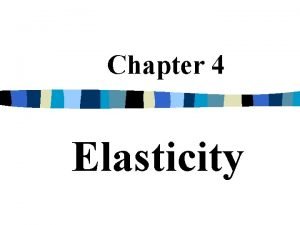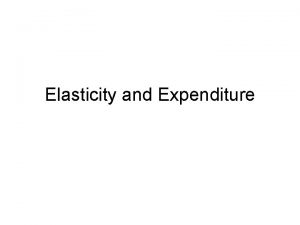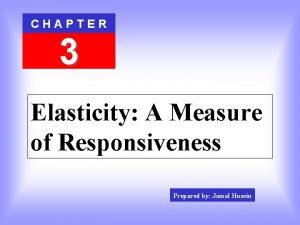Elasticity A measure that shows the responsiveness of







- Slides: 7

Elasticity • A measure that shows the responsiveness of one variable to changes in another. • A measure used by firms in pricing decisions of goods and services. • Price Elasticity of Demand is considered to determine if a price increase will impact on quantity demanded more, in proportionate or less than the price change. Elasticity is classified as Elastic, Inelastic or Unitary.

Elasticity along the demand curve • The elasticity will vary depending on which part of the demand curve you use to measure the change in price. • Extremes in elasticity • Perfectly Elastic are horizontal. • Perfectly Inelastic are vertical.

Inelastic demand • Where PED < 1 • The response to a given change in price is a less proportionate change in quantity demanded. • Curves are drawn steep • An increase in price results in a increase in total revenue and a small change in quantity. • Few substitutes, necessity, low proportion of income, single use.

Elastic demand • Where PED>1 • The response to a given change in price is more proportionate change in QD. • Elastic curves are drawn flat. • An increase in price will bring a decrease in total revenue and large change in quantity. • Many substitutes, luxury good, high proportion of income, durable (lasts time).

Unit Elasticity – Unitary • Where PED = 1 • The response to a given change in price results in an equally proportionate change in QD. Any increase in price does not change revenue.

Calculations • Price elasticity of demand • Midpoint method = ∆Quantity (Q 1 + Q 2) / 2 ∆Price (P 1 + P 2) / 2 Percentage change method = %∆Q / %∆P Total revenue method = P TR = Inelastic = P TR = Elastic

Example • Good A had a fall in sales from 10, 000 units to 9, 000 units when the price was increased from $100 to $115. • Total revenue method = Price increased, Revenue (P x Q) increased from 1 m to 1, 035, 000 m so both increased so inelastic. • Midpoint method • (∆Q / average Q )/ (∆P / average price) = (1000 / 9500) / (15/107. 5) = 0. 105263157 / 0. 139534883 = 0. 75 Inelastic.













